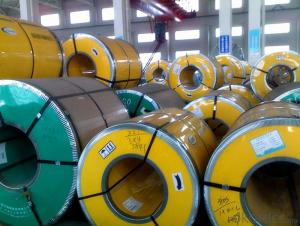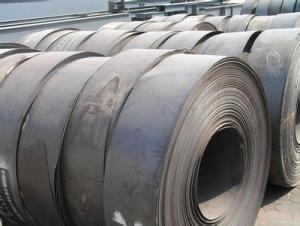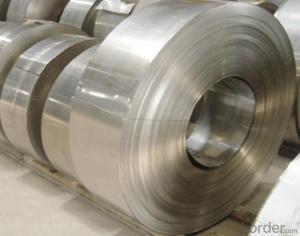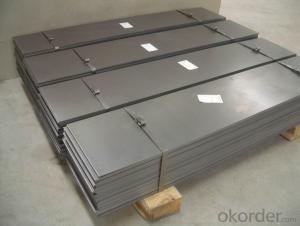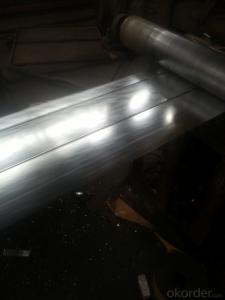Galvanized Steel Coil/Hot Dipped Galvanized Steel Strips Coil
- Loading Port:
- Tianjin
- Payment Terms:
- TT OR LC
- Min Order Qty:
- 1000 m.t.
- Supply Capability:
- 100000 m.t./month
OKorder Service Pledge
OKorder Financial Service
You Might Also Like
Galvanized Steel Coil/Hot Dipped Galvanized Steel Strips Coil Description:
Galvanized steel coil are widely used in the construction industry, as raw material for the production of corrugated panels, fencing products, drywall panel profiles, ventilation systems etc. Recommended for both outside and inside usage, galvanized steel has a high resistance to corrosion in different environments, due to a protective layer of zinc of 100 – 180 grams per square metre.
Main Features of Galvanized Steel Coil/Hot Dipped Galvanized Steel Strips Coil:
Hotdip galvanized steel coils are produced by immersing steel in a zinc bath. An appropriate galvanizing process requires a pretreatment process during which the steel passes through different baths which prepare the surface for zinc coating. In this stage, chemicals are used to clean the surface of the steel. After the chemical treatment, the steel coils pass through a bath of melted zinc at temperatures around 460 ° C. The resulting uniform coating is finished through a process of skin-passing to provide smooth and shiny appearance of the finished product. To store for a longer period, the hot-dip galvanized coils can be delivered with a final oil coating, according to the customer’s demand.
Galvanized Steel Coil/Hot Dipped Galvanized Steel Strips Coil Images:
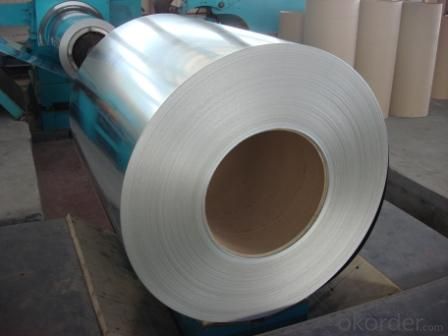
Galvanized Steel Coil/Hot Dipped Galvanized Steel Strips Coil Specifications:
Steel strips coils galvanized
Material: Q195, Q215, Q235, Q345B, SGCC, DX51D+Z
Thickness:0.75-4.5mm
Width:32-750mm
Zinc coating: 60-550g/m2
ITEM | |
Production | prime hot dipped galvanized steel strip coil |
Port | Tianjin, China |
Category | Minerals & metallurgy |
Thickness | 0.17-3.0mm |
Width | 600-1950mm |
Material Grade | SGCC,SGCH,SGCD1-SGCD3,DX51D |
Spangle | normal spangle, large spangle, small(min) spangle, zero spangle |
Technique | cold rolled,hot dipped galvanized |
Standard | ASTM,GB ,AISI,JIS,EN |
Test | With Hydraulic Testing, Eddy Current , Infrared Test |
Application | Widely used for roofs, outer walls, ovens, explosive-proof steel, electrically controlled cabinets,galvanized tube/pipe, ceiling channel, building material |
Surface | Galvanized |
Package | covered with waterproof-paper,strapped by strips. Or as customer’s requirement |
Sample | Common products, we can provide freely, for special production,we can depends on negotiation. |
MOQ | 5 tons |
Payment | 100% L/C at sight, 30% T/T in advance, and the balance against the copy of B/L or negotiation |
Delivery time | Within 10-25 days, according to quantity, asap save customer’s time |
Certificate | ISO9001:2008 |
FAQ:
Q: Are you manufacturer of trading company?
A: Yes.
- Q:How are steel strips processed for joining?
- Steel strips can be joined using various methods, depending on the specific requirements of the application. Welding, for example, involves heating the strips to a high temperature and fusing them together with a filler material. This results in a durable and secure bond. Alternatively, soldering can be utilized if the steel strips have a thin or delicate coating that could be damaged by the intense heat of welding. In soldering, a filler metal with a lower melting point than the strips is melted to join them together. Furthermore, adhesive bonding is an option where a robust adhesive is applied between the steel strips. This method is often preferred when a more flexible or aesthetically pleasing joint is desired. Ultimately, the choice of joining method for steel strips depends on factors such as the desired strength, appearance, and functionality of the final product.
- Q:How are steel strips used in the production of metal staircases?
- Steel strips are widely used in the production of metal staircases due to their numerous advantages. Firstly, they offer structural support and stability to the staircase framework. Often, they serve as the primary structural components, functioning as stringers or supports that uphold the treads and risers. With their high strength and rigidity, steel strips enable the construction of robust and long-lasting staircases capable of withstanding heavy loads and constant usage. Furthermore, steel strips are utilized in fabricating the treads and risers themselves. These strips are commonly shaped and welded together to form solid and secure steps, ensuring a safe and comfortable walking surface. Steel is the preferred material for this purpose because of its resistance to wear and tear, as well as its ability to withstand diverse environmental conditions. Moreover, steel strips can be tailored to meet the specific design requirements of the staircase. They can be cut, bent, and shaped into various sizes and profiles, allowing for the creation of unique and aesthetically pleasing staircases. This versatility enables the production of different styles, including straight, spiral, and curved staircases. Lastly, steel strips can be given different coatings or treatments to enhance their appearance and protect them from corrosion. This guarantees that the metal staircases retain their visual appeal and functionality over time, even in demanding environments. In summary, steel strips play a pivotal role in the production of metal staircases by providing structural support, forming the treads and risers, allowing for customization, and offering protection against corrosion. Their strength, durability, and versatility make them an ideal choice for constructing safe and visually appealing staircases.
- Q:How are steel strips used in the production of electrical contacts?
- Steel strips are used in the production of electrical contacts as they provide the necessary strength and conductivity required for reliable electrical connections. These strips are typically made of high-quality steel alloys that offer excellent electrical conductivity while exhibiting good mechanical properties. The steel strips are first cut into precise dimensions and then undergo various manufacturing processes to shape them into the desired form of electrical contacts. They are often stamped or punched to create the required shape, such as flat or curved contacts. Once the contacts are formed, they are often plated or coated with a thin layer of precious metals like silver or gold. This plating enhances the electrical conductivity of the contacts and also provides corrosion resistance, ensuring long-term reliability of the electrical connections. Steel strips are also used as the base material for bimetallic contacts, which are commonly used in devices where temperature changes can affect the performance of electrical connections. Bimetallic contacts consist of two different metals bonded together, with one metal strip made of steel and another made of a material with a different coefficient of thermal expansion. This combination allows the contacts to expand and contract at different rates, ensuring reliable electrical connections even under varying temperature conditions. In summary, steel strips play a crucial role in the production of electrical contacts by providing the necessary strength, conductivity, and versatility required for various applications. Whether used as standalone contacts or as part of bimetallic structures, steel strips form the backbone of reliable electrical connections in a wide range of devices and systems.
- Q:Can the tension leveller eliminate the wave shape of strip steel completely?
- Deformation of strip in tension and bending. There are two sides of the strip wave, the edge of the long fiber and short fiber into the middle; stretching and straightening machine Zhang Ligun, high tension length of the fiber are elastic deformation, the deformation is in the same length; bending roll, tensile and bending interaction length of the fiber plastic the deformation happened, Wuxi Tiangong metallurgical production straightening machine total length is still the same, which is different from the original long fiber produced by plastic deformation is small, the original short fiber produced by large plastic deformation; tension and bending stress to remove all strip elastic deformation recovery, leaving only the plastic deformation, then the original short fiber than long fibers obtained permanent large plastic deformation, long fiber length and narrow the gap, but still a long long fiber, short fiber is still relatively short.
- Q:What are the different thicknesses of steel strips available?
- There are various thickness options available for steel strips, ranging from very thin gauges like 0.005 inches (0.13 mm) to thicker ones such as 0.5 inches (12.7 mm) or even more. The specific thicknesses depend on the intended application and can be customized to meet specific requirements.
- Q:Are steel strips suitable for the manufacturing of agricultural equipment?
- Yes, steel strips are suitable for the manufacturing of agricultural equipment. Steel is a strong and durable material that can withstand the harsh conditions and heavy use often encountered in agricultural settings. It provides the necessary strength and structural integrity required for equipment such as plows, cultivators, and harvesters. Additionally, steel strips can be easily shaped and manipulated to meet specific design requirements, making them a versatile choice for agricultural equipment manufacturing.
- Q:How are steel strips used in the agricultural sector?
- Steel strips are widely used in the agricultural sector for various purposes. They are commonly used to reinforce and support agricultural structures such as greenhouses, barns, and sheds. Additionally, steel strips are employed in the construction of machinery and equipment used in farming activities, including tractors, plows, and cultivators. Their high strength and durability make them ideal for withstanding the harsh conditions and heavy loads commonly encountered in agricultural operations.
- Q:How do steel strips compare to stainless steel strips?
- Steel strips and stainless steel strips have various differences. Steel strips are made from carbon steel, which is an alloy of iron and carbon, while stainless steel strips are made from a combination of iron, carbon, and chromium. This chromium content in stainless steel strips provides superior corrosion resistance compared to regular steel strips. Stainless steel strips are also highly resistant to staining, rust, and oxidation. Additionally, stainless steel strips have a more polished and shiny appearance compared to steel strips. However, steel strips are generally more cost-effective than stainless steel strips. Ultimately, the choice between steel strips and stainless steel strips depends on the specific requirements of the application, including factors such as corrosion resistance, aesthetic appeal, and budget.
- Q:Can steel strips be used in the production of surgical implants?
- Yes, steel strips can be used in the production of surgical implants. They are often used as a raw material for manufacturing various types of implants, such as plates, screws, and rods, due to their strength, biocompatibility, and corrosion resistance. Steel strips are commonly utilized in orthopedic, dental, and reconstructive surgeries to provide stability and support in the body.
- Q:What are the common surface treatments for steel strips?
- There are several common surface treatments for steel strips that are used to enhance their appearance, protect against corrosion, or improve their performance. These treatments include: 1. Hot-dip galvanizing: This process involves immersing the steel strip in a bath of molten zinc, which forms a protective coating on the surface. It provides excellent corrosion resistance and can extend the lifespan of the steel strip. 2. Electro-galvanizing: Similar to hot-dip galvanizing, this method involves applying a layer of zinc to the steel strip through an electrolytic process. It offers good corrosion resistance and is often used for thinner steel strips. 3. Electroplating: This treatment involves coating the steel strip with a thin layer of a different metal, such as chrome or nickel, through an electrochemical process. It can enhance the aesthetics of the steel strip and provide additional corrosion resistance. 4. Phosphating: This process involves treating the steel strip with a phosphoric acid solution, which converts the surface into a layer of phosphate crystals. Phosphating improves the adhesion of subsequent coatings and provides corrosion resistance. 5. Painting or powder coating: Applying a layer of paint or powder coating onto the surface of the steel strip can enhance its appearance, provide corrosion resistance, and improve durability. These coatings can be customized with various colors and finishes. 6. Passivation: This treatment involves treating the steel strip with an acid solution to remove impurities and create a passive oxide layer on the surface. Passivation improves corrosion resistance and is commonly used for stainless steel strips. 7. Pickling: This process involves immersing the steel strip in an acid solution to remove surface impurities, such as rust or scale. Pickling can improve the surface finish and prepare the steel strip for subsequent treatments or coatings. These surface treatments for steel strips are often chosen based on the desired level of corrosion resistance, appearance, and specific application requirements. Different industries and applications may require specific treatments to ensure the steel strips perform optimally in their intended use.
1. Manufacturer Overview |
|
|---|---|
| Location | |
| Year Established | |
| Annual Output Value | |
| Main Markets | |
| Company Certifications | |
2. Manufacturer Certificates |
|
|---|---|
| a) Certification Name | |
| Range | |
| Reference | |
| Validity Period | |
3. Manufacturer Capability |
|
|---|---|
| a)Trade Capacity | |
| Nearest Port | |
| Export Percentage | |
| No.of Employees in Trade Department | |
| Language Spoken: | |
| b)Factory Information | |
| Factory Size: | |
| No. of Production Lines | |
| Contract Manufacturing | |
| Product Price Range | |
Send your message to us
Galvanized Steel Coil/Hot Dipped Galvanized Steel Strips Coil
- Loading Port:
- Tianjin
- Payment Terms:
- TT OR LC
- Min Order Qty:
- 1000 m.t.
- Supply Capability:
- 100000 m.t./month
OKorder Service Pledge
OKorder Financial Service
Similar products
New products
Hot products
Related keywords





















